Deck 2: Innate Immunity: the First Lines of Defense
Question
Question
Question
Question
Question
Question
Question
Question
Question
Question
Question
Question
Question
Question
Question
Question
Question
Question
Question
Question
Question
Question
Question
Question
Question
Question
Question
Question
Question
Question
Question
Question

Unlock Deck
Sign up to unlock the cards in this deck!
Unlock Deck
Unlock Deck
1/32
Play
Full screen (f)
Deck 2: Innate Immunity: the First Lines of Defense
1
The production of antimicrobial peptides is one of the most evolutionarily ancient mechanisms of defense for multicellular organisms, and most eukaryotic species make many different forms of these proteins. For instance, human paneth cells in the gastrointestinal epithelium make 21 different defensins. The reason for this diversity of antimicrobial peptides is:
A) Epithelial cells make different forms than those made by neutrophils.
B) Neutrophils make many different defensins and store them as inactive proteins in their secretory granules.
C) Most of them are produced only in response to infection.
D) The production of different peptides is induced following a bacterial infection versus a fungal infection.
E) Each one has distinct activities against Gram-negative bacteria, Gram-positive bacteria, or fungi.
A) Epithelial cells make different forms than those made by neutrophils.
B) Neutrophils make many different defensins and store them as inactive proteins in their secretory granules.
C) Most of them are produced only in response to infection.
D) The production of different peptides is induced following a bacterial infection versus a fungal infection.
E) Each one has distinct activities against Gram-negative bacteria, Gram-positive bacteria, or fungi.
Each one has distinct activities against Gram-negative bacteria, Gram-positive bacteria, or fungi.
2
Women with urinary tract infections caused by
A) The E. coli infection damages the reproductive epithelium, causing a breach in the tight junctions and allowing invasion by the Candida albicans.
B) The E. coli infection induces adhesion molecule expression on the reproductive epithelium, allowing attachment of the yeast.
C) The antibiotic treatment kills all strains of fungi present in the reproductive tract, except the Candida albicans.
D) The E. coli infection causes gastrointestinal distress leading to diarrhea.
E) The antibiotics kill many of the commensal organisms in the reproductive tract, allowing overgrowth of the fungus.
A) The E. coli infection damages the reproductive epithelium, causing a breach in the tight junctions and allowing invasion by the Candida albicans.
B) The E. coli infection induces adhesion molecule expression on the reproductive epithelium, allowing attachment of the yeast.
C) The antibiotic treatment kills all strains of fungi present in the reproductive tract, except the Candida albicans.
D) The E. coli infection causes gastrointestinal distress leading to diarrhea.
E) The antibiotics kill many of the commensal organisms in the reproductive tract, allowing overgrowth of the fungus.
The antibiotics kill many of the commensal organisms in the reproductive tract, allowing overgrowth of the fungus.
3
Antibodies, complement proteins, and phagocytic cells provide effective protection against all of the following types of infections in Figure , except:
A)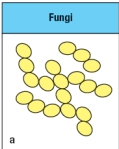
B)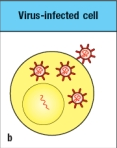
C)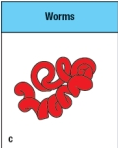
D)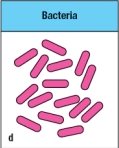
E)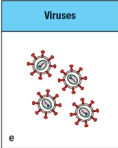
A)

B)

C)

D)

E)


4
The classical and lectin pathways of complement activation converge at the step of C3 activation. However, the initiating steps of each pathway use protein components and enzymatic mechanisms that share no similarity with each other.

Unlock Deck
Unlock for access to all 32 flashcards in this deck.
Unlock Deck
k this deck
5
Mucosal surfaces and external epithelia are major routes of pathogenic infection. Mucosal surfaces are found in tissues such as the gastrointestinal tract, the reproductive tract and the mouth and respiratory tract. While the mouth and respiratory tract are routes of virus but not bacterial infections, the gastrointestinal tract is the route for bacterial but not virus infections.

Unlock Deck
Unlock for access to all 32 flashcards in this deck.
Unlock Deck
k this deck
6
Opsonization of pathogens by both antibodies and complement proteins (C3b) leads to uptake and destruction of the pathogen by phagocytic cells that express both Fc receptors and complement receptors. Which of the following in Figure is the most efficient form of dual opsonization of the pathogen by antibody and C3b to maximize phagocytosis?
A)
B)
C)
D)
E)
A)

B)

C)

D)

E)


Unlock Deck
Unlock for access to all 32 flashcards in this deck.
Unlock Deck
k this deck
7
Neutrophils regulate the production of active cathelicidins (a class of antimicrobial peptides) by segregating the inactive propeptide from the processing enzyme that cleaves and activates it in two different types of cytoplasmic granules. These two types of granules are induced to fuse with phagosomes after ingestion of microbes, bringing the processing enzyme and the propeptide together.

Unlock Deck
Unlock for access to all 32 flashcards in this deck.
Unlock Deck
k this deck
8
The C3 convertase of the alternative complement pathway amplifies the overall magnitude of complement activation regardless of which of the three pathways initiated the complement activation initially.

Unlock Deck
Unlock for access to all 32 flashcards in this deck.
Unlock Deck
k this deck
9
Although the complement cascade can be initiated by antibodies bound to the surface of a pathogen, complement activation is generally considered to be an innate immune response. This is because:
A) Two of the three pathways for complement activation are initiated by constitutively produced recognition molecules that directly interact with microbial surfaces.
B) When the complement cascade leads to the formation of a membrane-attack complex, the pathogen is killed.
C) Several of the soluble products generated by complement activation lead promote the inflammatory response.
D) Complement proteins bound to the pathogen promote uptake and destruction by phagocytic cells.
E) The C3 convertase is only produced when complement activation is initiated by antibody binding to a pathogen.
A) Two of the three pathways for complement activation are initiated by constitutively produced recognition molecules that directly interact with microbial surfaces.
B) When the complement cascade leads to the formation of a membrane-attack complex, the pathogen is killed.
C) Several of the soluble products generated by complement activation lead promote the inflammatory response.
D) Complement proteins bound to the pathogen promote uptake and destruction by phagocytic cells.
E) The C3 convertase is only produced when complement activation is initiated by antibody binding to a pathogen.

Unlock Deck
Unlock for access to all 32 flashcards in this deck.
Unlock Deck
k this deck
10
The formation of the C3 convertase is a key step in complement activation that occurs in all three complement pathways. This enzyme cleaves C3 in blood plasma, leading to a conformational change in the C3b fragment that exposes its reactive thioester group. The activated C3b is potentially harmful to the host, if it becomes covalently attached to a host cell, rather than to the surface of a pathogen. This deleterious outcome is largely avoided by:
A) The inability of active C3b to diffuse away in the blood plasma.
B) The inability of active C3b to covalently attach to the membranes of eukaryotic cells.
C) The rapid hydrolysis of active C3b in solution, rendering it inactive.
D) The tight binding of active C3b to the C3 convertase.
E) The ability of active C3b to recruit phagocytic cells.
A) The inability of active C3b to diffuse away in the blood plasma.
B) The inability of active C3b to covalently attach to the membranes of eukaryotic cells.
C) The rapid hydrolysis of active C3b in solution, rendering it inactive.
D) The tight binding of active C3b to the C3 convertase.
E) The ability of active C3b to recruit phagocytic cells.

Unlock Deck
Unlock for access to all 32 flashcards in this deck.
Unlock Deck
k this deck
11
Pathogenic infections induce damage to the host by a variety of mechanisms. While many mechanisms are direct effects of the pathogen, some damaging mechanisms result from the immune response to the infection, as illustrated in Figure . Examples of damage caused by the host immune response are:
A)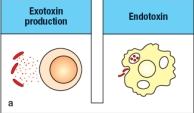
B)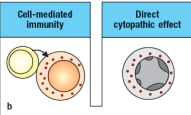
C)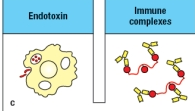
D)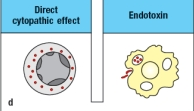
E)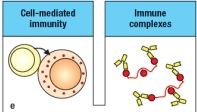
A)

B)

C)

D)

E)


Unlock Deck
Unlock for access to all 32 flashcards in this deck.
Unlock Deck
k this deck
12
Infants and young children with deficiencies in specific complement components present with recurrent respiratory infections caused by extracellular bacteria. The peak age of susceptibility is between 6 and 12 months after birth. At this time, as shown in Figure , maternal antibodies acquired by the child during fetal gestation are nearly gone, but the child is not yet generating robust antibody responses to new infections, as indicated by the low circulating levels of IgG and IgA. As children with this immunodeficiency get older, they outgrow this disease and show no further evidence of these recurrent infections. Based on this information, name one likely gene deficiency (in the complement system) that could cause this primary immunodeficiency, and the specific complement pathway likely to be affected. Explain your answer. 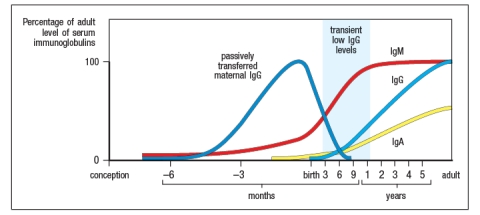


Unlock Deck
Unlock for access to all 32 flashcards in this deck.
Unlock Deck
k this deck
13
Epithelial surfaces provide the first line of defense against infection by the use of several types of mechanisms. One of the chemical mechanisms used by epithelia is:
A) Joining of epithelial cells by tight junctions
B) Secretion of antimicrobial peptides by epithelial cells
C) Production of mucus, tears, or saliva in the nose, eyes, and oral cavity
D) Movement of mucus by cilia
E) Peristalsis in the gastrointestinal tract
A) Joining of epithelial cells by tight junctions
B) Secretion of antimicrobial peptides by epithelial cells
C) Production of mucus, tears, or saliva in the nose, eyes, and oral cavity
D) Movement of mucus by cilia
E) Peristalsis in the gastrointestinal tract

Unlock Deck
Unlock for access to all 32 flashcards in this deck.
Unlock Deck
k this deck
14
One form of anemia results when individuals have a deficiency in the enzyme phosphatidylinositol glycan A (PIGA). This enzyme is required for the membrane attachment of proteins anchored by glycolipids to the plasma membrane, using what is called a 'GPI-linkage.' Included in the group of GPI-linked cell surface proteins is DAF/CD55. These individuals become anemic because:
A) DAF/CD55 prevents the lysis of red blood cells by infecting pathogens.
B) DAF/CD55 normally prevents the spleen from clearing healthy red blood cells from the circulation.
C) In the absence of PIGA, the red blood cell membrane is bare of proteins allowing increased access of complement activating proteins to attach to the cell membrane.
D) DAF/CD55 is a complement inhibitory protein that inactivates any C3 convertase that may form on host cell surfaces.
E) In the absence of PIGA, red blood cells are unable to synthesize high levels of hemoglobin.
A) DAF/CD55 prevents the lysis of red blood cells by infecting pathogens.
B) DAF/CD55 normally prevents the spleen from clearing healthy red blood cells from the circulation.
C) In the absence of PIGA, the red blood cell membrane is bare of proteins allowing increased access of complement activating proteins to attach to the cell membrane.
D) DAF/CD55 is a complement inhibitory protein that inactivates any C3 convertase that may form on host cell surfaces.
E) In the absence of PIGA, red blood cells are unable to synthesize high levels of hemoglobin.

Unlock Deck
Unlock for access to all 32 flashcards in this deck.
Unlock Deck
k this deck
15
Streptococcus pneumoniae is a Gram-positive bacterium that colonizes the mucosal surface of the upper respiratory tract in humans. The presence of this bacterium in the nose and throat is widespread in the population, and in most people, colonization with Strep. pneumoniae is asymptomatic. Figure shows a comparison of in vitro growth curves of the wild-type strain of Strep. pneumoniae, as well as a Strep. pneumoniae mutant strain with a defect in one bacterial gene. The graph on the right shows the growth curve following addition of lysozyme during the logarithmic phase of bacterial growth. 
Which statement could account for the data in these graphs?
A) Strain B is wild-type Strep. pneumoniae, and strain A is a mutant that cannot modify its peptidoglycan to be lysozyme-resistant.
B) Strain B is wild-type Strep. pneumoniae, and strain A is a mutant that that expresses increased levels of LPS.
C) Strain A is wild-type Strep. pneumoniae, and strain B is a mutant that cannot modify its peptidoglycan to be lysozyme-resistant.
D) Strain A is wild-type Strep. pneumoniae, and strain B is a mutant that secretes an enzyme that inactivates lysozyme.
E) Strain A is wild-type Strep. pneumoniae, and strain B is a mutant that cannot grow well in vitro.

Which statement could account for the data in these graphs?
A) Strain B is wild-type Strep. pneumoniae, and strain A is a mutant that cannot modify its peptidoglycan to be lysozyme-resistant.
B) Strain B is wild-type Strep. pneumoniae, and strain A is a mutant that that expresses increased levels of LPS.
C) Strain A is wild-type Strep. pneumoniae, and strain B is a mutant that cannot modify its peptidoglycan to be lysozyme-resistant.
D) Strain A is wild-type Strep. pneumoniae, and strain B is a mutant that secretes an enzyme that inactivates lysozyme.
E) Strain A is wild-type Strep. pneumoniae, and strain B is a mutant that cannot grow well in vitro.

Unlock Deck
Unlock for access to all 32 flashcards in this deck.
Unlock Deck
k this deck
16
Patients with recurrent infections of Neisseria meningitidis, an extracellular bacterial pathogen that causes meningitis, were examined to determine the underlying cause of their immunodeficiency. A subset of these patients were found to have defects in complement activation on the bacterial surface, a process that for this bacterium is dominated by alternative complement activation leading to C3b deposition on the pathogen surface. When neutrophils from these patients were examined in vitro, the results in Figure were obtained. 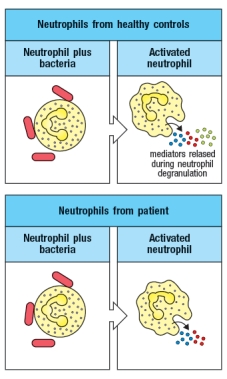
Based on these data, the identity of the green neutrophil mediator in Figure is likely to be:
A) Complement factor B
B) The C3 convertase
C) Factor P (properdin)
D) C3b
E) Mannose-binding lectin (MBL)

Based on these data, the identity of the green neutrophil mediator in Figure is likely to be:
A) Complement factor B
B) The C3 convertase
C) Factor P (properdin)
D) C3b
E) Mannose-binding lectin (MBL)

Unlock Deck
Unlock for access to all 32 flashcards in this deck.
Unlock Deck
k this deck
17
The classical complement pathway is initiated by C1q binding to the surface of a pathogen. In some cases, C1q can directly bind the pathogen, for instance by recognizing proteins of bacterial cell walls, but in most cases C1q binds to IgM antibodies that are bound to the pathogen surface. How does this IgM-binding feature of C1q contribute to rapid, innate immune responses rather than to slow, adaptive responses?
A) C1q induces B lymphocytes to begin secreting antibody within hours of pathogen exposure.
B) Natural antibody that binds to many microbial pathogens is produced prior to pathogen exposure.
C) C1q binds to C-reactive protein which then binds to IgM on the pathogen surface.
D) C1q directly induces inflammation, recruiting phagocytes and antibodies from the blood into the infected tissue.
E) C1q binds to dendritic cells in the infected tissue, inducing them to secrete inflammatory cytokines.
A) C1q induces B lymphocytes to begin secreting antibody within hours of pathogen exposure.
B) Natural antibody that binds to many microbial pathogens is produced prior to pathogen exposure.
C) C1q binds to C-reactive protein which then binds to IgM on the pathogen surface.
D) C1q directly induces inflammation, recruiting phagocytes and antibodies from the blood into the infected tissue.
E) C1q binds to dendritic cells in the infected tissue, inducing them to secrete inflammatory cytokines.

Unlock Deck
Unlock for access to all 32 flashcards in this deck.
Unlock Deck
k this deck
18
Our environment contains masses of microorganisms, many of which reside as commensal organisms on our body's mucosal and epithelial surfaces without causing disease. What two features distinguish a pathogenic microbe from these commensal microbes?

Unlock Deck
Unlock for access to all 32 flashcards in this deck.
Unlock Deck
k this deck
19
Mannose binding lectins (MBL) and ficolins are the two classes of proteins that can initiate the lectin pathway of complement activation. These proteins are selective for activating complement on the surfaces of microbial pathogens rather than host cells because:
A) Their higher-order oligomeric structure can be assembled only after the monomers first bind to pathogen membranes.
B) They only recruit MASP (MBL-associated serine proteases) proteins when bound to pathogen surfaces and not when bound to host cells.
C) They only undergo the conformational change needed to activate MASP proteins when bound to a pathogen and not when bound to a host cell.
D) They only bind to carbohydrate side chains and oligosaccharide modifications found on pathogen surfaces but not on host cell membranes.
E) The activated MASP proteins are rapidly inactivated by hydrolysis when present on the surface of a host cell.
A) Their higher-order oligomeric structure can be assembled only after the monomers first bind to pathogen membranes.
B) They only recruit MASP (MBL-associated serine proteases) proteins when bound to pathogen surfaces and not when bound to host cells.
C) They only undergo the conformational change needed to activate MASP proteins when bound to a pathogen and not when bound to a host cell.
D) They only bind to carbohydrate side chains and oligosaccharide modifications found on pathogen surfaces but not on host cell membranes.
E) The activated MASP proteins are rapidly inactivated by hydrolysis when present on the surface of a host cell.

Unlock Deck
Unlock for access to all 32 flashcards in this deck.
Unlock Deck
k this deck
20
The alternative pathway of complement activation has an important role in innate immunity, due to its ability to greatly amplify the amount of C3b deposited onto the pathogen surface. This amplification occurs because:
A) The C3 convertase of the alternative pathway is much more active than those of the classical and lectin pathways.
B) The C3 convertase of the alternative pathway works as a soluble enzyme in the plasma.
C) The C3 convertase of the alternative pathway cannot be inactivated by complement regulatory factors in the host.
D) The C3 convertase of the alternative pathway is more efficiently recruited to pathogen surfaces than the C3 convertases of the classical and lectin pathways.
E) The C3 convertase of the alternative pathway contains C3b, and can generate more of itself.
A) The C3 convertase of the alternative pathway is much more active than those of the classical and lectin pathways.
B) The C3 convertase of the alternative pathway works as a soluble enzyme in the plasma.
C) The C3 convertase of the alternative pathway cannot be inactivated by complement regulatory factors in the host.
D) The C3 convertase of the alternative pathway is more efficiently recruited to pathogen surfaces than the C3 convertases of the classical and lectin pathways.
E) The C3 convertase of the alternative pathway contains C3b, and can generate more of itself.

Unlock Deck
Unlock for access to all 32 flashcards in this deck.
Unlock Deck
k this deck
21
Pseudomonas aeruginosa is a Gram-negative bacterium that causes severe, and often life-threatening infections in immunocompromised individuals. In susceptible individuals, P. aeruginosa can establish infections in a wide range of tissues, including the lung, the GI tract, the eye, the ear, the urinary tract, the skin, and the blood. This bacterium is common in the environment, and is found on the skin of approximately 5% of healthy individuals. It is often found on hospital equipment, such as ventilators and catheters, and as a consequence, P. aeruginosa accounts for ~10% of hospital-acquired infections. To study the role of complement in the early innate immune response to P. aeruginosa, the following studies in mice were performed. Mice deficient in complement C3 or C5 (C3-/- or C5-/-, respectively) were infected by intratracheal inoculation with 105 colony forming units (CFU) of P. aeruginosa, and survival was monitored over the first 72 hrs post-infection. The data from these studies are shown in Figure . Genetic data from human population studies also indicate that Individuals with genetic deficiencies in one of the collectins or ficolins show increased susceptibility to P. aeruginosa infections.
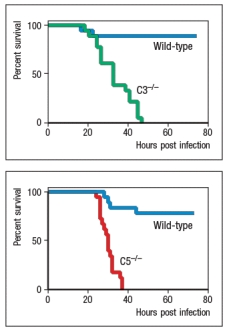
a) Based on these data, evaluate the importance of complement in protection against P. aeruginosa infection, and describe the most likely complement pathway(s) involved in pathogen recognition and in pathogen destruction.
Another group of individuals that are highly susceptible to P. aeruginosa infections are patients with the disease cystic fibrosis. These individuals suffer from the production of a thick mucus secretion in their lungs, which clogs the bronchial tubes. A similar increase in viscosity of bodily secretions is seen in these patients' sweat, digestive fluid, and gastrointestinal mucus. In these patients, the most common form of lung infection is that of P. aeruginosa.
b) What is the most likely explanation for the increased susceptibility of cystic fibrosis patients to P. aeruginosa and other infections?

a) Based on these data, evaluate the importance of complement in protection against P. aeruginosa infection, and describe the most likely complement pathway(s) involved in pathogen recognition and in pathogen destruction.
Another group of individuals that are highly susceptible to P. aeruginosa infections are patients with the disease cystic fibrosis. These individuals suffer from the production of a thick mucus secretion in their lungs, which clogs the bronchial tubes. A similar increase in viscosity of bodily secretions is seen in these patients' sweat, digestive fluid, and gastrointestinal mucus. In these patients, the most common form of lung infection is that of P. aeruginosa.
b) What is the most likely explanation for the increased susceptibility of cystic fibrosis patients to P. aeruginosa and other infections?

Unlock Deck
Unlock for access to all 32 flashcards in this deck.
Unlock Deck
k this deck
22
Although homozygous deficiencies in complement regulatory proteins cause serious diseases, more subtle alterations in the balance of complement activation versus inhibition have been found to contribute to disease susceptibility. Describe the genetic evidence linking subtle alterations in complement regulatory proteins to disease susceptibility.

Unlock Deck
Unlock for access to all 32 flashcards in this deck.
Unlock Deck
k this deck
23
Four different clinical isolates of the Gram-positive bacterium, Staphylococcus aureus, are tested for their abilities to resist innate immune defense mechanisms. For these experiments, each bacterial strain is first grown in culture to achieve log-phase replication, and then cultures are supplemented with dilutions of human serum containing normal serum proteins as well as antibodies capable of binding to S. aureus. One hour later, the cultures are analyzed and the numbers of live bacteria are quantitated. The data from this experiment are shown in Figure .
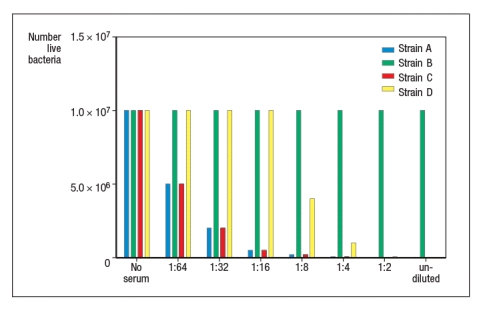
a) From these data, what general conclusions can be reached about the four strains of S. aureus?
To identify the bactericidal mechanisms killing each strain of S. aureus, the serum is depleted of complement C3 by running it over an anti-complement C3 antibody affinity column. The experiment above is then repeated and the data are shown in Figure .
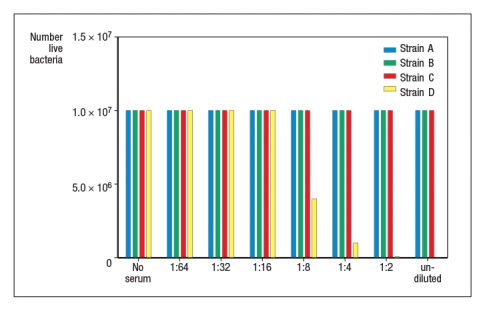
b) What is the most likely mechanism accounting for the killing of strain D in this experiment?
To determine whether strains A and C are susceptible to the same microbicidal pathway, the serum is depleted of antibody by running over an anti-human immunoglobulin affinity column. Following this treatment, it is found that strain A, but not strain C is still killed by incubation with the serum.
c) From these data, what is the most likely mechanism killing S. aureus strain A? What about strain C?

a) From these data, what general conclusions can be reached about the four strains of S. aureus?
To identify the bactericidal mechanisms killing each strain of S. aureus, the serum is depleted of complement C3 by running it over an anti-complement C3 antibody affinity column. The experiment above is then repeated and the data are shown in Figure .

b) What is the most likely mechanism accounting for the killing of strain D in this experiment?
To determine whether strains A and C are susceptible to the same microbicidal pathway, the serum is depleted of antibody by running over an anti-human immunoglobulin affinity column. Following this treatment, it is found that strain A, but not strain C is still killed by incubation with the serum.
c) From these data, what is the most likely mechanism killing S. aureus strain A? What about strain C?

Unlock Deck
Unlock for access to all 32 flashcards in this deck.
Unlock Deck
k this deck
24
Recent studies using mouse models of pulmonary inflammation (a model for human asthma) have found that mice deficient in the C3a receptor have greatly reduced disease symptoms when challenged with inhaled preparations containing extracts of the fungal pathogen Aspergillus fumigatus. Specifically, the C3a receptor-deficient mice showed reduced influx of granulocytes and lymphocytes into the lung and reduced fluid in the lung after challenge. What is the explanation for these findings?

Unlock Deck
Unlock for access to all 32 flashcards in this deck.
Unlock Deck
k this deck
25
Even when the complement cascade fails to proceed beyond generating the C3 convertase, complement activation is effective at inducing pathogen uptake and destruction. This process of immune protection is mediated by:
A) Activation of complement inhibitory receptors on phagocytes that promote pathogen uptake
B) Activation of soluble proteases in the serum that disrupt pathogen membranes
C) Engagement of complement receptors on phagocytes by C3b and its cleavage products which promotes phagocytosis
D) Engagement of complement receptors on B cells that promotes antibody production
E) Stimulation of antimicrobial peptide secretion by phagocytes
A) Activation of complement inhibitory receptors on phagocytes that promote pathogen uptake
B) Activation of soluble proteases in the serum that disrupt pathogen membranes
C) Engagement of complement receptors on phagocytes by C3b and its cleavage products which promotes phagocytosis
D) Engagement of complement receptors on B cells that promotes antibody production
E) Stimulation of antimicrobial peptide secretion by phagocytes

Unlock Deck
Unlock for access to all 32 flashcards in this deck.
Unlock Deck
k this deck
26
The C3 convertase amplifies the process of complement activation by generating large amounts of C3b and cleaving large numbers of C5 molecules.

Unlock Deck
Unlock for access to all 32 flashcards in this deck.
Unlock Deck
k this deck
27
In vertebrates, complement activation generally involves a pathogen recognition step followed by a proteolytic cascade that produces the effector proteins that function in opsonization, membrane attack, and inflammation.
a) Which of these is likely to be the most evolutionarily primitive aspect of the complement system?
b) Which pathway of complement initiation is likely to be the one that most recently evolved?
a) Which of these is likely to be the most evolutionarily primitive aspect of the complement system?
b) Which pathway of complement initiation is likely to be the one that most recently evolved?

Unlock Deck
Unlock for access to all 32 flashcards in this deck.
Unlock Deck
k this deck
28
Several pathogens produce proteins, either membrane-bound or secreted, that inactivate C3b that might be deposited on the pathogen surface. C3b is specifically targeted due to its central position in all three complement pathways.

Unlock Deck
Unlock for access to all 32 flashcards in this deck.
Unlock Deck
k this deck
29
The terminal components of the complement pathway assemble to form a membrane attack complex that can induce pathogen lysis and death. Yet, evidence indicates that this feature of complement is less important than the earlier steps that promote pathogen opsonization and induce inflammation. This conclusion is based on:
A) In vitro experiments showing that very few species of bacteria are susceptible to lysis by the membrane attack complex
B) Experiments indicating that only bacteria, but not viruses or fungi, are susceptible to lysis by the membrane attack complex
C) The very low levels of terminal complement components in the serum
D) The fact that other mammalian species lack the terminal components of the complement pathway needed to form the membrane attack complex
E) The limited susceptibility to infections of patients with deficiencies in terminal complement components
A) In vitro experiments showing that very few species of bacteria are susceptible to lysis by the membrane attack complex
B) Experiments indicating that only bacteria, but not viruses or fungi, are susceptible to lysis by the membrane attack complex
C) The very low levels of terminal complement components in the serum
D) The fact that other mammalian species lack the terminal components of the complement pathway needed to form the membrane attack complex
E) The limited susceptibility to infections of patients with deficiencies in terminal complement components

Unlock Deck
Unlock for access to all 32 flashcards in this deck.
Unlock Deck
k this deck
30
Multiple pathways for regulating complement activation limit the potential damage caused by complement deposition on host cells or caused by the spontaneous activation of complement proteins in the plasma. Genetic deficiencies in these mechanisms often lead to chronic inflammatory diseases, but in some cases can paradoxically lead to increased susceptibility to bacterial infections. This latter outcome may occur because:
A) Complement regulatory proteins have dual functions in inhibiting and promoting complement activation.
B) Uncontrolled complement activation leads to the depletion of serum complement proteins.
C) The inhibition of the membrane attack complex by complement regulatory proteins normally leads to enhanced activation of the early steps of the complement pathway.
D) Complement regulatory proteins normally cause the rapid depletion of plasma complement factors.
E) Uncontrolled complement activation recruits the majority of phagocytic cells, leaving few remaining to fight infections in the tissues.
A) Complement regulatory proteins have dual functions in inhibiting and promoting complement activation.
B) Uncontrolled complement activation leads to the depletion of serum complement proteins.
C) The inhibition of the membrane attack complex by complement regulatory proteins normally leads to enhanced activation of the early steps of the complement pathway.
D) Complement regulatory proteins normally cause the rapid depletion of plasma complement factors.
E) Uncontrolled complement activation recruits the majority of phagocytic cells, leaving few remaining to fight infections in the tissues.

Unlock Deck
Unlock for access to all 32 flashcards in this deck.
Unlock Deck
k this deck
31
The importance of complement activation as an innate immune defense against infections is illustrated by:
A) The evolution of complement avoidance strategies by many pathogens
B) The large number of proteins involved in the complement pathway
C) The large number of complement regulatory pathways expressed by the host
D) The existence of three different mechanisms for initiating complement activation
E) The ability of the membrane attack complex to lyse some pathogens
A) The evolution of complement avoidance strategies by many pathogens
B) The large number of proteins involved in the complement pathway
C) The large number of complement regulatory pathways expressed by the host
D) The existence of three different mechanisms for initiating complement activation
E) The ability of the membrane attack complex to lyse some pathogens

Unlock Deck
Unlock for access to all 32 flashcards in this deck.
Unlock Deck
k this deck
32
B cells express a complement receptor that binds to C3b cleavage products, such as iC3b and C3dg. When a B cell with an antigen receptor that specifically recognizes that pathogen also has its complement receptor stimulated because the pathogen is opsonized with these C3 fragments, B cell activation is greatly enhanced. Due to this mechanism, B cells can be activated by much lower concentrations of antigen (in this case, the pathogen) than if the antigen is devoid of complement components. This mechanism functions to:
A) Ensure that pathogens are readily detected by the adaptive immune system before they replicate to high levels in the host
B) Prevent B cells from being activated in response to antigens that are not pathogens
C) Allow B cells to phagocytose the pathogen and help destroy it
D) Induce increased rounds of B cell replication to make more pathogen-specific B cells
E) Allow the B cell to block pathogen replication by interfering with multiple pathogen surface functions
A) Ensure that pathogens are readily detected by the adaptive immune system before they replicate to high levels in the host
B) Prevent B cells from being activated in response to antigens that are not pathogens
C) Allow B cells to phagocytose the pathogen and help destroy it
D) Induce increased rounds of B cell replication to make more pathogen-specific B cells
E) Allow the B cell to block pathogen replication by interfering with multiple pathogen surface functions

Unlock Deck
Unlock for access to all 32 flashcards in this deck.
Unlock Deck
k this deck



